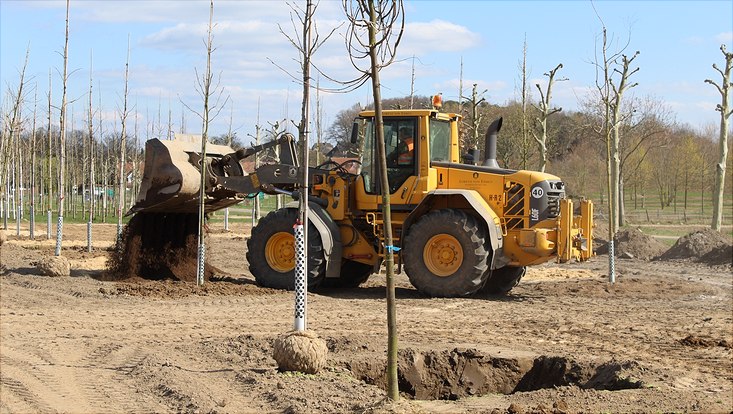Putting Urban Trees to the Test
29 September 2022, by Alexander Schütt

Photo: UHH/CEN/A. Schütt
Providing shade and cooling the air, trees are vital to the quality of human’s life in Hamburg. However, our trees face challenging conditions along streets – and with climate change. In particular, freshly planted trees are thus subjected to stress, indicated by slow growth and failure gain large canopies. How can we provide the next generation to be climate-change-proof?
In order to determine which tree species cope best with extremely dry conditions, my team at Universität Hamburg’s Center for Earth System Research and Sustainability (CEN) designed an experiment. For three years, we studied nine different species, with in 135 individual young trees, at the tree nursery Lorenz von Ehren. Thereby the soil substrate – a type of artificial soil provided for the planting of young trees in cities – is the key determinant.

Many areas along streets consist of sandy soils, often the result of construction work. Sand is coarse porous and thus cannot store much water plant available; However, it is well suited to gas exchange. In contrast, fine soil, soft like flour, can store more water due to higher capillary forces. Nevertheless, in reverse, fine soil is more prone to compaction, e.g. caused by traffic or construction sites.
For our experiment, we aimed to represent urban-like conditions along streets in the nursery. Therefore, we planted two-thirds of our test trees in two different types of soil: one consisted of pure sand, which composition was frequently found along streets (95% sand); and a representative for a commonly used artificial soil-substrate with 93% sand but elevated humus content. This leads to slightly elevated water holding capacity.
As a reference, we planted the final third of the trees in the natural fertile nursery’s soil. Featuring even more humus and a finer structure, it offers ideal growing conditions and can hold up to four times more water compared to the sandy soil. In addition, we buried 300 sensors in the soil beneath the trees to monitor water consumption over the three years of root growing.
Our findings: Although all trees planted in the two sandy substrates survived, these conditions were found to limit growth substantially compared to the reference soil and were thus only poorly suited for dry periods. The sandy substrates measured a water availability of only six to ten percent, compared to 23 percent in the ideal soil.
We also determined that the trees in the sandy substrates weren’t even able to fully tap the water available. Caused by its coarse-porous structure the water filled capillary spaces become incoherent when sandy soil dries out. As a result, the flow of water to the roots is interrupted, which is less is less likely, the finer the soil is structured.
As a result, trees like the small-leaved linden and sweetgum, whose roots essentially grow to follow the water, coped in our experiment better when planted in sandy soils. In contrast, trees that can produce substantial negative pressure to still take up water in dry soils – like the goldenrain tree and Turkey oak – proved to have the less successful strategy.
Our conclusion: no tree can grow properly under the insufficient conditions. The soils found along streets are often of low quality. Consequently, it is essential that young trees be planted in sufficiently large pits and in improved substrates capable of storing more water. Though the recommended size for these pits is twelve cubic meters, the larger it is, the better.
More Information
Alexander Schütt is a member of the CEN and is investigating trees under climate change at Universität Hamburg’s Institute of Soil Science.
Research Paper: Schütt A, Becker JN, Reisdorff C, Eschenbach A (2022): Growth Response of Nine Tree Species toWater Supply in Planting Soils Representative for Urban Street Tree Sites; Forests 2022, 13, 936.
Newspaper: This article was first published as a guest article in the Hamburger Abendblatt as part of a monthly series on climate research. Find all articles of the series here.


